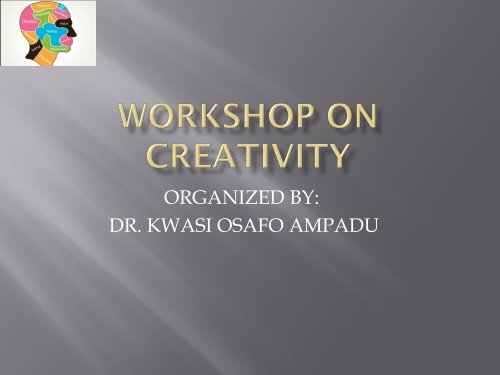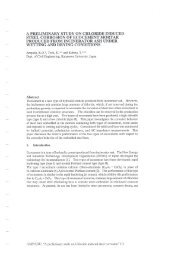Introduction-to-the-Design-Process
You also want an ePaper? Increase the reach of your titles
YUMPU automatically turns print PDFs into web optimized ePapers that Google loves.
ORGANIZED BY:<br />
DR. KWASI OSAFO AMPADU
Be Creative<br />
Step out of your<br />
comfort zone<br />
<strong>to</strong><br />
Implement<br />
your idea
• At <strong>the</strong> end of <strong>the</strong> workshop<br />
participants would be able <strong>to</strong><br />
1. Identify <strong>the</strong>ir talent<br />
2. Understand all <strong>the</strong> ten processes that<br />
one has <strong>to</strong> undertake <strong>to</strong> create a<br />
product, service, or solve a problem in<br />
one’s business<br />
3. Execute a Project by applying all <strong>the</strong> ten<br />
processes <strong>to</strong> create a product, service, or<br />
solve a problem in one’s business
• Every Child is creative during <strong>the</strong>ir formative years,<br />
however due <strong>to</strong> societal pressure; <strong>the</strong>y conform <strong>to</strong><br />
<strong>the</strong> norms of <strong>the</strong>ir community.<br />
• In <strong>the</strong> process of conforming <strong>to</strong> Society, creativity is<br />
pushed <strong>to</strong> <strong>the</strong> background but not lost al<strong>to</strong>ge<strong>the</strong>r.<br />
• Creativity can be rekindled.<br />
• Creativity is sterile if action does not follow from it<br />
• Ideas must be evaluated, improved, polished and<br />
marketed before <strong>the</strong>y have any value.<br />
• The basic assumption is that everyone is creative and<br />
by focusing on a creative approach <strong>to</strong> work each<br />
person can improve <strong>the</strong>ir success in life.
1. Identification of a need (or Problem<br />
Formulation)<br />
2. Background Research<br />
3. Goal Statement<br />
4. Performance Specifications (or<br />
Required Level of Service)<br />
5. Idea Generation and Invention
6. Analysis of ideas<br />
7. Selection of best idea<br />
8. Detailed <strong>Design</strong><br />
9. Pro<strong>to</strong>typing and Testing (or Pilot<br />
Study)<br />
10.Production(or Implementation)
• this is not a process in which one<br />
proceeds from step one through ten<br />
in a linear fashion.<br />
• Ra<strong>the</strong>r it is, by its nature, an iterative<br />
process in which progress is made<br />
haltingly, two steps forward and one<br />
step back. It is inherently circular.
• To iterate means <strong>to</strong> repeat, <strong>to</strong> return<br />
<strong>to</strong> a previous state.<br />
• If, for example, your apparently great<br />
idea, upon analysis, turns out <strong>to</strong><br />
violate a scientific law or principle,<br />
you can return <strong>to</strong> <strong>the</strong> ideation step<br />
and get a better idea! or <strong>to</strong> an earlier<br />
step in <strong>the</strong> process, perhaps <strong>the</strong><br />
background research, and learn more<br />
about <strong>the</strong> problem.




